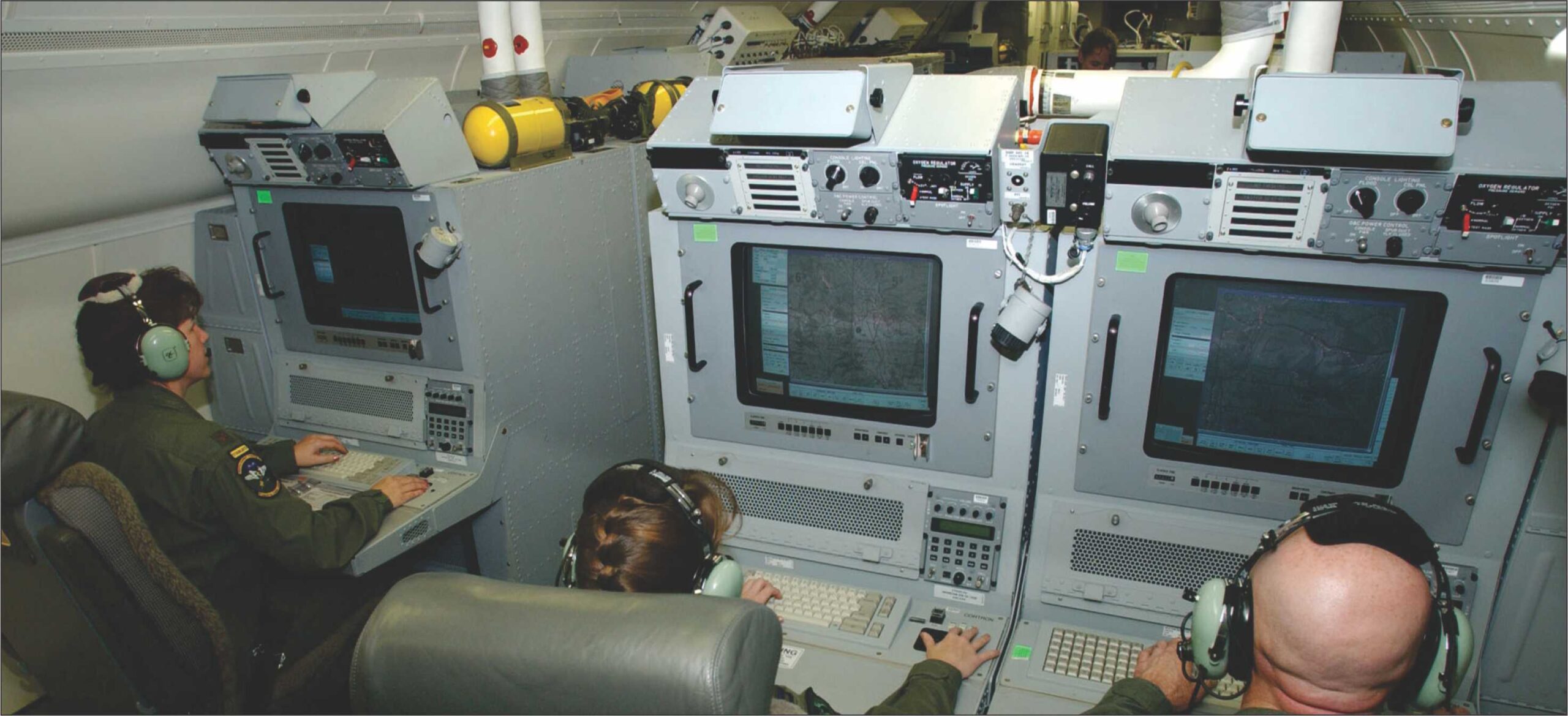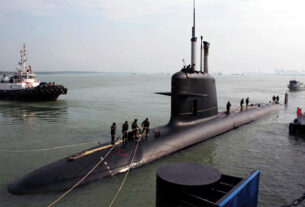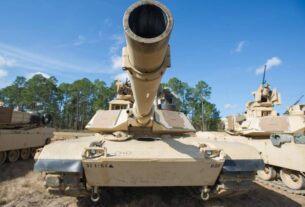Aerial surveillance and modern ISR-cum-AWACS technology
With the introduction of space based modern technological platforms, militaries are looking for instant and around the clock information superhighways which can lead them to analyze exact nature of threat and fast counter response to neutralize the enemy.
In this regard, the principal function of the intelligence, surveillance, and reconnaissance (ISR) component of command, control, communications, computers, intelligence, surveillance, and reconnaissance (C4ISR) is to find, fix, and track both friendly and hostile forces, as well as to assess damage to hostile targets in an area of interest, in addition to sensing (collection), the function includes the tasking of sensors and the integration, interpretation, and exploitation of sensed information.
The ISR capabilities of naval strike groups are provided by a host of naval, joint, and national sensor systems that can be space-based, airborne, on-the-surface, and subsurface platforms, and by a number of ground- and ship-based systems for the tasking of the sensors and exploitation of the sensor data.
Today, most nations have powerful space-based image intelligence (IMINT), signals intelligence (SIGINT), and measurement and signatures intelligence (MASINT) collection systems and is in the process of developing even greater capabilities. It is essential that naval forces have access to data from these capabilities and that they be able to task the capabilities.
National IMINT systems provide photographic coverage over denied territory that, through the science of stereophotogrammetry, enables precise geodetic positioning of targets on the ground.
For decades these capabilities have provided the means for precision strike against fixed targets; as the speed of tasking, collection, and processing has increased, the same capabilities have begun to put relocatable targets at risk. The US is investing into ISR capabilities in a new fashion.
New satellite constellations are in progress under the Future Imagery Architecture program of the National Reconnaissance Office (NRO).
SIGINT systems have global coverage and provide geodetic positioning of platforms emitting at radio frequencies. Their product is quickly and widely broadcast to tactical forces afloat and in the field, where it is used for strike targeting and defense avoidance and suppression, among other purposes.
Defence Support Program (DSP) satellites for decades served as sentinels for the early warning of the launch of strategic intercontinental ballistic missiles.
Without a reliable ISR system, the defence forces today will be incapacitated to act against any threat.
In recent years the infrared-based MASINT data from these satellites have been exploited to cue systems defending against shorter-range tactical ballistic missiles.
In addition, the DSP ability to estimate launch points enables counterattack against elusive Transportable Erector Launchers (TELs). New, more capable systems denoted Space-Based Infrared Systems (SBIRS) High and Low are under development.
Defence Meteorological Support Program (DMSP) satellites and related space, atmospheric, and surface observations are used by the Fleet Numerical Meteorological and Ocean Center (FNMOC) to make now-casts and forecasts of a wide variety of oceanographic and atmospheric variables.
Such surface wind and wave forecasts are of the utmost importance in naval operations as well as in planning ISR observations.
FNMOC forecasts are especially valuable over ocean areas where other meteorological forecasting services do not provide the information necessary for effective naval air and surface operations.
Greater reliance
Naval strike groups today rely on a large number of disparate systems, sometimes with overlapping capabilities, for tasking and exploitation.
The Tactical Control System was a DOD attempt to achieve a common system for controlling UAVs and receiving data from them, but as new UAVs have been introduced, the number of separate control systems has been increasing.
Similarly, the US DOD directed the development of a common Joint Service Imagery Processing System (JSIPS), but only the Navy version, JSIPS-N, came to fruition.
The US Naval Air Systems Command developed JSIPS-N and later the Precision Targeting Workstation (PTW) for using imagery to derive geodetic targeting coordinates for the Tomahawk cruise missile and tactical aircraft.
The US Army developed the Tactical Exploitation System (TES) and interested the Naval Sea Systems Command in using a naval variant (TES-N) on surface combatant ships. The two systems (JSIPS-N and TES-N) have overlapping capabilities and produce somewhat different results.
As targets get quieter and if passive systems are to be used, detections will be very intermittent and short-lived, there is a need to direct and deploy assets very quickly to an area of interest before the data become old and the search problem must be reinitiated.
Surface ships and submarines do not have the speed to carry out this kind of detection scenario unless they happen to be near the target.
This fundamental change in the character of acoustic ASW, from long-range persistent detection and tracking to much shorter-range, intermittent detection and tracking, requires an ISR system built more on sensor networking than on the older, platform-on-platform approach.
However, the state of the art for both distributed wide-area surveillance acoustic systems (needed for cueing tactical ASW forces) and for distributed large-area tactical ASW acoustic sensors (needed to achieve high search rates in the absence of surveillance cues) is limited by current command, control, and communications (C3) constraints.
The ASW surveillance systems of today rely on passive acoustics and fiberoptic cable to send information back to operators for detection and classification.
But reliance on cable makes it difficult to employ the surveillance arrays on the ocean bottom rapidly and/or covertly, and cable-based systems are subject to trawling and other human-made measures that can greatly undermine their survivability and/or persistence.
In order to be free of such problems with cables, it will be necessary to increase the in-array automated detection and classification capabilities for each surveillance node (by employing multispectral sensors and advanced computer-aided detection and classification algorithms).
These capabilities in turn will reduce the total RF communications bandwidth requirement (size of the “pipe”) for a large field of distributed surveillance arrays.
Nevertheless, there is much technology still to be demonstrated in this area, including the ability to communicate from far forward locales off an adversary’s coast by low- probability-of-detection/interception (LPD/LPI) methods and to link such ships as the LCS and its modules beyond line of sight, as needed.
The ASW large-area search systems are typically sonobuoy-based and reliant on active acoustic multistatic techniques to achieve high contact rates in offensive or defensive roles.
Today, active multistatic techniques are largely made possible by having P-3 aircraft constantly monitoring the distributed field.
ASW operations
These P-3 aircraft are tied up indefinitely reseeding and monitoring these sensor fields, and they are potentially vulnerable to adversaries’ countermeasures (attacks on the aircraft or their bases in areas where air superiority is being contested).
Once again, with breakthroughs in sensor processing to reduce the RF communications bandwidth requirements and in battery technology (to increase system endurance from hours to at least a few days), there would be less reliance on P-3s for reseeding and monitoring.
They would be freed up for other tasks (ASW and non-ASW). But the “long pole in the tent” is, of course, a successful communications architecture that is able to get timely multi-static contact information to tactical ASW assets on the scene (note that most of these contacts will end up being false contacts as opposed to real targets, which is the nature of active acoustics).
These active multistatic systems will only prove useful if the information generated from them can be successfully correlated and fused to form a relatively coherent undersea picture.
Finally, unmanned vehicle programs are progressing toward a variety of ASW applications, ranging from UAVs equipped with nonacoustic sensors for large-area search, to unmanned surface vehicles (USVs) equipped with active sources as part of multistatic operations, and to unmanned underwater vehicles (UUVs) relying on special onboard sensors that can support covert tracking and trailing operations against adversaries’ submarines during pre-hostilities.
Yet, command and control (C2) of unmanned vehicles is not very mature and will ultimately depend on advances in acoustic and RF communications.
For example, advanced acoustic communications techniques between UUVs, surveillance arrays, and host SSNs will need to be stealthy and reliable to facilitate future covert operations off an adversary’s coast.
In summary, advanced sensors, signal processing, communications, and C2 techniques are the keys to future distributed ASW sensor operations-and even though “it’s the sensor, stupid” is still axiomatic in ASW, “it’s the network, stupid” is equally true.
Without a robust sensor network and stand-off weapons that can rapidly respond to moving ASW contact information, ASW will continue to earn its reputation as the awfully slow warfare area that ties up a lot of manned assets for incremental gains in a painful war of attrition.
Over the past 60 years, modern electronics and guidance technology have brought tremendous progress in the ability to place a weapon precisely on a ground target.
Precision aerial bombing has reduced the number of bombs required to kill a ground target, from more than 1,000 bombs per target in World War II to 1.5 bombs per target in Operation Iraqi Freedom.
Similar gains are also anticipated with the emerging technology of guided artillery shells, as typified by the enhanced-range guided munition (ERGM).
Technological evolution, driven in large part by Moore’s law and the Global Positioning System (GPS), both enables the sensor technology to measure the target coordinates and enables the guidance technology to steer the bomb to the target.
For example, national IMINT systems enable the precise geolocation of fixed targets for prosecution by weapons accurately guided by the GPS.
Air-launched, laser-guided weapons enable precision strikes, even on moving targets. But targeting processes associated with national IMINT systems are too slow for relocatable targets and are vulnerable to the countermeasure of hiding, while laser-guided weapons put pilots at risk.
Target location
So today it is relocatable, hiding and moving targets that challenge the nation’s strike capabilities in major combat operations.
Potential solutions to these shortfalls involve layered ISR sensing capabilities that in correlated aggregate provide persistent surveillance.
Another realm among potential solutions is that of tasking and exploitation. Today the time required for sensors to respond to a commander’s tasking is typically too long for tactical utility; thus, when a deficiency or uncertainty in the ISR is recognized, the commander cannot correct the problem; that is, tasking is essentially open loop.
Furthermore, commanders have few tools for recognizing deficiencies in the ISR picture-for example, seeing that certain areas have not been adequately searched.
Also, ISR systems today produce a collection of information products from a disparate set of uncoordinated national, theater, and battle force-organic sensors (synthetic aperture radar SAR, EO, IR, SIGINT, ground moving target indicator GMTI).
This varied array of sensors is capable of producing large numbers of reports, but unfortunately in a range of different formats.
The potential of these sensors for saving knowledge is rarely achieved. Tactical commanders and their staffs typically have neither the skills nor the tools to recognize the relevance of these reports and to interpret them.
The ISR system of tasking, collection, integration, interpretation, and exploitation is viewed as a system of systems. This system of systems should function as a closed-loop process in order to provide the ISR information needed to support a commander’s intent.
Tomorrow’s systems should have the goal of delivering what commanders want when they want it-which means giving commanders a stronger degree of control over ISR collection, tools to assess ISR adequacy, and an ISR product that provides timely situational understanding.
Sensor products should be integrated for full information value and the results presented in a low-burden (or quickly understandable) form to permit faster reaction.
Sensor coverage should be comprehensive, wide-area, and controllable. Target locations should be precisely geo-registered.
The information should be captured in a dynamically updated, geo-referenced database, and that database should be of low burden to the war fighter.
Threat information should be cast in a hierarchical fashion, with the most critical, time-sensitive information sent in the most compact fashion so as to reach even communications-disadvantaged users quickly.
The advent of network-centric operations presents an opportunity to use as ISR assets platforms that will be present in mission execution.
The US Navy can leverage its investments in F/A-18 and F-35 sensors and communications to interlace the surveillance and tracking roles of an ISR asset with the roles of a strike asset.
This opportunity is enabled by the improved sensor capability of modern AESA radars, which are capable of air-to-air modes as well as air-to-ground imaging and GMTI tracking modes.
The US Navy should explore the concept of networking F-18 E/F and F-35 platforms together to provide a persistent surveillance dwell time during a strike engagement.
This use of aircraft over targets for ISR has high potential, since it exploits the presence of strike assets that have already penetrated an adversary’s air defenses and have a great positional advantage.
The committee calculates that three strike packages of four aircraft each, using AESA radars, can map terrain at a rate equal to the rate at which two and one half Global Hawk UAVs could accomplish the task.
There is an increasing demand for creating, as a key component in Navy ISR architecture, movement intelligence, or MOVINT, as a new ISR source and method that could provide significant benefits in future engagements.
MOVINT exploits movement and change on a battlefield to provide important indications of an adversary’s activity. The surveillance systems designed to detect these changes provide a coarse filter that directs attention to specific locations and activities for more-focused observation.
ISR potential
This coarse filter limits the energy expended by scarce ISR resources in looking at regions where no activity is occurring, increasing chances that these resources will be looking at the right place at the right time. Additionally, movement by an adversary is a powerful denial and deception method that must be countered.
The first steps for the Navy to take in order to create a MOVINT capability are to exploit motion and change on the battlefield by architecting a system of collection assets working in a highly integrated cross-cueing and tasking network.
This network of sensors, in which one sensor’s observation of motion cues the next level of detailed observation in a cascading fashion across the network of systems, provides an efficient observation of an adversary for understanding the adversary’s actions.
This understanding will be possible only if one studies an adversary’s habits on the battlefield and identifies statistical norms that underlie the enemy’s daily activity.
This information-rich environment requires the development of automated exploitation tools that key on movement and change and allow human attention to focus on events and activity of potential significance.
This environment requires new concepts that look at changes in a scene, not on a pixel-by-pixel basis but rather as a whole-for example, by overlays providing detection of event-level change.
The key enabler of MOVINT capability is the emergence of airborne and space-based radar for persistent ISR coverage and its unique combination of high-resolution SAR and high-range-resolution ground moving target indicator (HRR-GMTI) radar technology.
This capability allows one to measure movement and change over wide areas in an efficient manner and then to focus imagery on the important changes in a region.
Automated exploitation systems are required to digest sensor information and extract significant changes and to manage the large increase in data and necessary background information, for example, Precision Digital Terrain Elevation Data.
By adopting and employing a surveillance capability to understand and track an adversary’s changes on the battlefield, the Navy can maximize the utility of its strike forces.
Some may argue that the methods described above should not be called intelligence in the same way that image intelligence or signals intelligence are.
Consider, however, measurement and signatures intelligence, MASINT. It can be seen that a strong parallel between MOVINT and MASINT.
Both represent an ensemble of technologies and approaches aimed at determining some characteristic of a threat.
MASINT aims at determining the threat’s physical attributes, while MOVINT aims at determining its movement.
DARPA has been conducting a series of programs developing technologies for ISR tasking and exploitation.
Its Advanced ISR Management (AIM) program developed technology for coordinated collection planning for a heterogeneous mix of airborne and space-based ISR platforms.
The AIM algorithms route the airborne platforms and schedule the sensors of both classes of platforms in order to optimize the accomplishment of prioritized collection tasks.
The AIM program demonstrated the ability to automatically develop a 24 hour collection plan for a theater-scale scenario (thousands of collection tasks for tens of collection platforms) in 10 minutes.
Moreover, by finely coordinating the routes and schedules of the platforms, the number of collection tasks successfully performed increased by over 40 percent compared with the number performed under a conventional, stovepiped plan in which collection tasks were partitioned between platforms prior to plan development.
New programs
DARPA’s Dynamic Database (DDB) program developed technology to convert large volumes of space-based and airborne multisensor data efficiently into actionable information for tactical commanders.
The DDB demonstration dealt with the problem of developing and maintaining a surveillance picture of moving ground targets in a brigade-size area (nominally 30 km × 30 km).
Typically such an area contains thousands of moving objects. The DDB goal was to create situational awareness of the battlespace, including location, kinematics, tracks, and identifications.
As envisioned, the DDB would provide the automation required to translate the relevant data from a sensor perspective to a tactical perspective-that is, to a map-based view of all objects in the battlespace.
Besides, the DARPA Dynamic Tactical Targeting (DTT) program is continuing the technology development begun under the DDB and AIM programs and is integrating exploitation with ISR collection management.
A closed-loop tasking-exploitation-tasking ISR information system learns from its continuous data accumulation over multiple observations, accruing and assessing evidence to determine if further tasking is needed to resolve residual target ambiguities.
If the vision of persistent surveillance is achieved, the amount of information that can be brought to bear can greatly improve the nation’s warfighting capabilities, but that promise can only be achieved if the information can be managed through closed-loop, automated systems.
A system such as that cannot cope with the enormous amounts of data involved and operate in a timely manner without the extensive use of automated systems.
Global Net Centric Surveillance and Targeting (GNCST) is a prototyping effort within the Assistant Secretary of Defense for Networks and Information Integration (ASD[NII]) Horizontal Fusion (HF) portfolio for demonstrating the integration of warfighting capabilities into the GIG architecture.
It is highly classified and is sponsored by the National Geospatial-Intelligence Agency (NGA). Fifteen organizations have been contributing to an effort to produce the best set of algorithms and processes for information fusion.
The primary premise of the effort is to apply automated upstream fusion of signals from national assets to allow earlier association of emitting and non-emitting target signatures.
Theory and simulations indicate that it is possible to have higher detection probability while maintaining false-alarm control and high-fidelity identification.
In the first HF Quantum Leap experiments, the prototype processes of GNCST successfully demonstrated these attributes.
With the elimination of all elements of the HF portfolio except those projects directly useful to the Iraq and Afghanistan campaigns, GNCST is in a hiatus, with the NGA, the NRO, and the Air Force exploring a transition to an acquisition program.
New opportunities in ultralong endurance, defined as longer than 5 days, will enable new levels of performance in the airborne segment.
Today, the Global Hawk offers up to 30 hours of endurance; it is most effective when its airbases are within 500 nmi of the region of interest.
Multiple orbits of Global Hawks using three Global Hawks per orbit can provide coverage 24 hours per day, 7 days per week at a rate of 40,000 nmi2 per day at 1 meter resolution.
Nearly the entire land area of Earth can be covered from just one airbase using two UAVs with 10 day endurance.
Long-endurance airships can show similar benefits owing to their promised endurance but will suffer longer deployment times because of slow velocity.
Next-generation, ultra-HALE UAVs currently on the drawing boards promise to achieve 7 to 14 days’ endurance, carrying payloads comparable to that of today’s Global Hawk.
Ultra-HALE UAVs require a very efficient power plant and weight-efficient fuel. One approach is a hydrogen-powered internal combustion engine with a liquid hydrogen fuel tank.
Ultra-HALE UAVs were pioneered by DARPA’s Condor UAV, which achieved the altitude endurance record in the mid-1980s. A prototypical ultra-HALE UAV can be characterized by its very long (200 ft or greater) wings.
Several ideas are emerging for near-space platforms that are lighter than air (LTA) and may be able to maintain position in the stratosphere, at 65,000 to 100,000 ft altitude.
Having platforms in the stratosphere would allow for wider coverage than can be achieved by lower-elevation winged aircraft, better resolution than can be provided by satellites in geosynchronous orbit, and much longer persistence than is possible with lower-orbiting spacecraft, especially if the LTA craft could be deployed in numbers for coverage overlap with station-keeping over days or weeks.
A challenge for this class of systems is that of overcoming winds at northern latitudes in the winter months and being available a sufficiently high percentage of the time (e.g., 98 percent).
A new concept called High Altitude Reconnaissance Vehicle (HARVe)-the HARVe could be launched in a packed state in a Tomahawk missile airframe from a ship or aircraft and within hours deploy into an LTA propeller-driven platform at 70,000 to 100,000 ft.
This would allow a Navy strike group to carry its own deployable (and expendable or recoverable) ISR platforms in numbers to complement organic and national winged airborne ISR assets.
New opportunities
It is clear that there are many technological challenges to be overcome before this technology can be fielded and proven useful, but the idea of having a long-endurance sky hook is motivating.
During the Cold War, the US Navy had a strong interest in active space-based radar (SBR) systems for the surveillance and targeting of Soviet combatant ships. It developed several concepts such as Clipper Bow and the Integrated Tactical Surveillance System. None of these was fielded, however.
The SBR systems today may present the Navy with a new opportunity. Technology now permits SBR systems capable of SAR imagery and GMTI surveillance, making them useful for a variety of land and maritime surveillance roles and therefore making them of interest to all the Services.
The role that an SBR system can fill in an integrated system-of-systems surveillance system is both broad and critical. SBR systems can provide unrestricted access to every corner of the globe, at any time of day and in any weather.
With good system design, a constellation of SBR satellites can provide a high level of persistence over a significant portion of any theater of engagement.
This system’s unique bird’s-eye view is unparalleled in both reach and in diversity of viewing geometry. One such design, based on a LEO constellation of affordable satellites (estimated by DARPA at $100 million per satellite), called Discoverer II, was under R&D in the late 1990s.
In fact, US Congress canceled the Discoverer II project. However, it gave $30 million to the National Reconnaissance Office to pursue enabling technologies for the concept.
The measure of any wide-area surveillance system is its ability to survey a large region quickly and to uncover clues to an adversary’s forces and intent.
SBR has a unique ability to track objects on the ground through their move-stop-move cycle, using GMTI while the object is in motion and SAR when it is not.
The future potential of coherent change detection technology applied to SBR. A scenario of maritime surveillance and tracking of ships in the Persian Gulf and compares SBR performance with that of manned surveillance assets (JSTARS) and unmanned airborne systems (Global Hawk).




